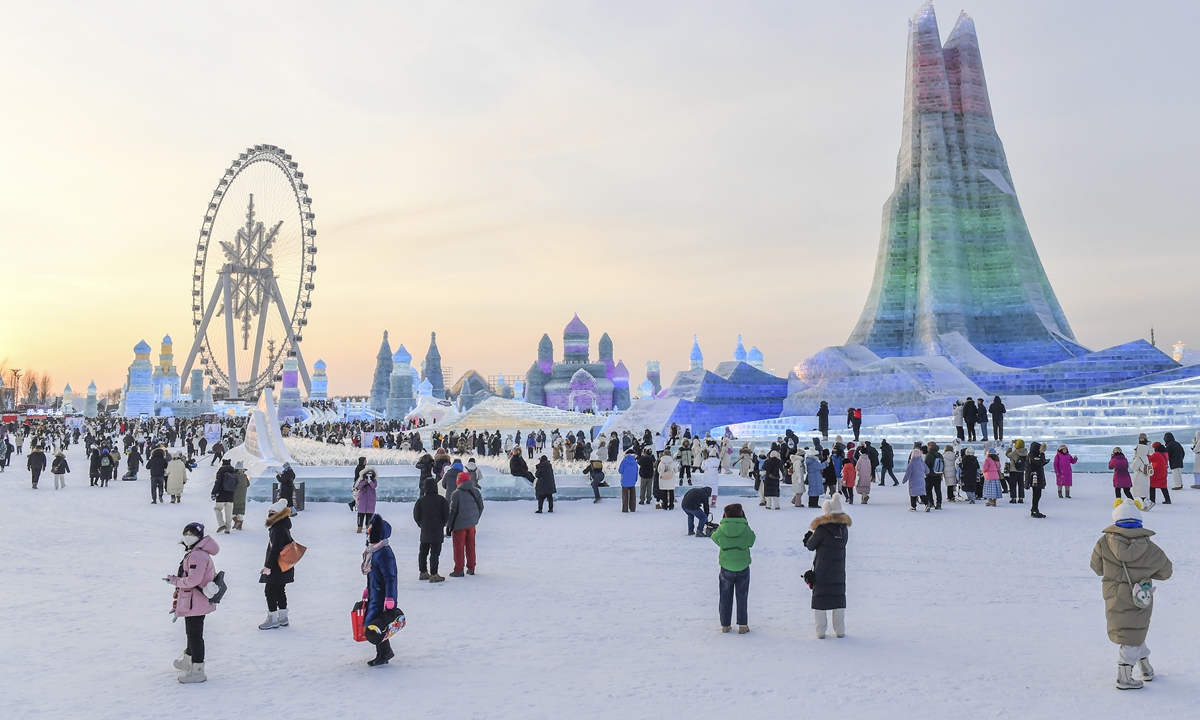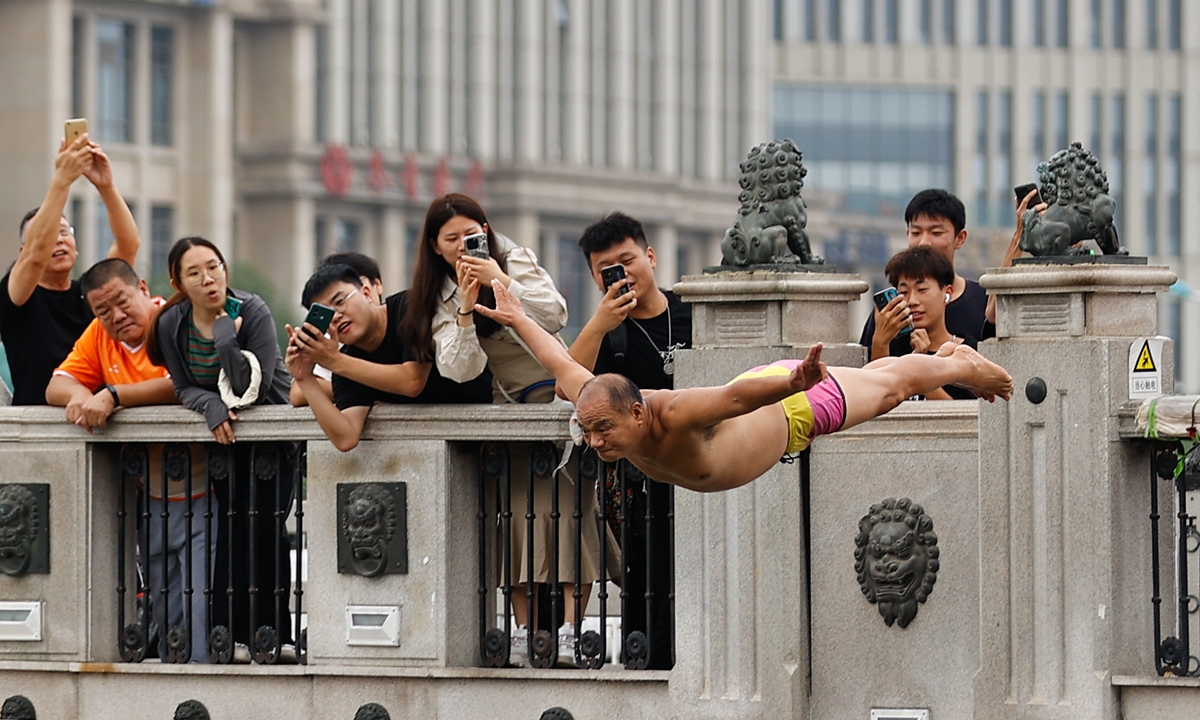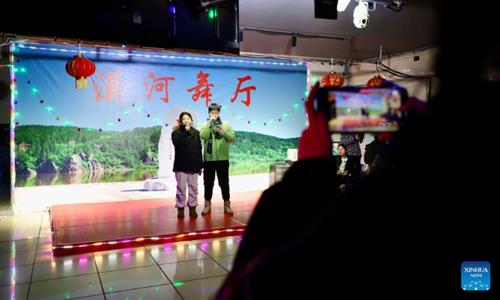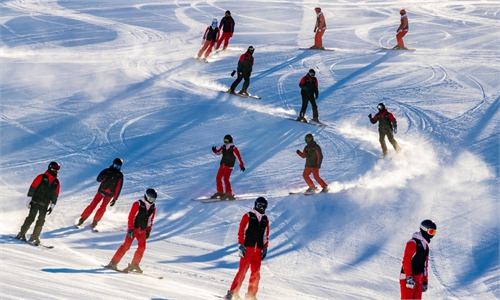
Tourists visit the Harbin Ice and Snow World. Photo: VCG
Editor's Note:
In 2023, a series of noteworthy topics have emerged in the Chinese cultural landscape. In the planning of the 2023 Cultural Gala, the Global Times will delve into nine important topics, aiming to showcase the multidimensional aspects of Chinese civilization and the diverse charms of Chinese culture.
This is the sixth installment in the Global Times' Year-end Special on culture, taking stock of the year's internet-famous cities. China's cultural and tourism markets are experiencing a robust resurgence. The trend of experiential consumption is not only reshaping travel preferences but also turning cities into domestic hot spots.

Tourists take photos as a Tianjin grandpa dives into the Haihe River. Photo: VCG
China's cultural and tourism markets have experienced a robust resurgence in 2023. One most striking feature of this year's tourism trend, is the rise of "hotspot" cities one after another, as people travel more and flock to these cities of interest to experience them and further contribute to their online trendsetting.
Whether savoring the culinary delights of Zibo, witnessing the daring dives of Tianjin's grandpas, experiencing the unique charm of Weihai, or immersing oneself in the enchanting ice and snow wonderland of Harbin, these cities exemplify the diverse offerings that contribute to the thriving cultural and tourism landscape.
According to data from the National Bureau of Statistics, end consumer expenditure contributed 83.2 percent of economic growth in the first three quarters, lifting GDP growth by 4.4 percentage points.
Rise of trendsetting cities
Zibo - once a modest city - has witnessed its "hottest summer" this year as it captivated the nation's attention through its unique culinary flair. Zibo barbecue, renowned for its immersive dining experience and affordability, offers a unique dining setting, with each table featuring a small stove, allowing diners to process and customize their skewers to be wrapped in thin pancakes. This culinary innovation has not only sparked gastronomic delight but also catalyzed local economic growth.
In response to the growing popularity of Zibo barbecue, the local government has taken proactive steps to boost tourism. Initiatives such as a customized "barbecue map" have significantly enhanced accessibility for tourists, transforming Zibo into a sought-after destination. Travel packages for Zibo have seen a remarkable 441 percent rise compared to the 2019 May Day holiday period, while short-term accommodation bookings have surged 12-fold.
Zhu Danpeng, a veteran analyst in the food industry, told the Global Times that China's emergence out of the pandemic reignited the hustle and bustle of cities. Social media promotion has also played a role in the popularity of certain domestic destinations.
He noted that Zibo is not the only city that has stepped up efforts to promote its characteristics. "At present, local governments all over the country are using characteristic scenery and local delicacies to create their own city calling cards.
In August, Tianjin municipality shifted its spotlight from traditional attractions to a group of spirited seniors known as the "Tianjin diving grandpas." Their daring water acrobatics on a local bridge became a social media sensation, attracting tourists with their impressive performances. Every day, people from across the country flocked to Tianjin and specifically the Shizilin Bridge on the Haihe River to see the grandpas diving and share the scenes on social media. Although the grandpas voluntarily stopped diving for the safety of the ever expanding crowds, by December, local aunties swimming in the freezing river became another online sensation, attracting huge crowds to Tianjin.
Additionally, Tianjin witnessed the rise of the "Tianjin Auntie Hairstyles." The old-school coiffed creations by local aunties involve intricately coiling hair using styling tools like hair ties and hairpins, creating diverse and stylish looks and attracting visitors who wish to indulge in the retro-chic dos.
Winter destinations
There's a popular sentiment online that southern netizens long for snow, while northern netizens long for the sea. Weihai, with its unique blend of both, satisfies the desires of both groups. The coastal city has leveraged its unique geographical and climatic conditions to become a sought-after travel destination during both summer and winter.
Hemmed in by the sea on three fronts and a mountainous landscape on the fourth, the city boasts Asia's largest wintering ground for swans. The picturesque landscapes and iconic hot springs, complemented by a variety of thematic experiences, including ice and snow activities, fresh seafood, local guesthouses, and bustling local fairs, have made Weihai an attractive destination for winter tourism.
Harbin, often referred to as China's "Ice and Snow City." Although the city hosts ice and snow festival every winter except during the pandemic, this year, it suddenly became the hottest destination especially during the coldest days, attracting visitors especially from the south of the country. The 25th edition of the Harbin Ice and Snow World, which covers an area of 810,000 square meters and uses a total of 250,000 cubic meters of ice and snow, has drawn immense interest, with ticket sales reaching a staggering 40,000 reservations on its opening day December 18.
Wang, a 26-year-old from Xiamen, East China's Fujian Province, is among the visitors who have enjoyed the ice world, which she described as "truly impressive."
Wang told the Global Times that she planned a four-day trip around Harbin to appreciate the ice sculptures. During her stay, she explored the Ice and Snow World, visiting a famous 18-meter-tall snowman, while also going skiing at the Yabuli Ski Resort.
The city's commitment to creating enchanting ice and snow experiences has not only stimulated tourism but has also positioned Harbin as a must-visit destination during the winter months.
With the rapid recovery of offline services, the resurgence of cultural and tourism consumption has become a noticeable trend, serving as a significant driver for domestic consumption prosperity.
In the first three quarters, the total number of domestic tourist visits reached 3.674 billion, a year-on-year increase of 75.5 percent. The total expenditure on domestic trips by residents amounted to 3.69 trillion yuan, a remarkable year-on-year growth of 114.4 percent, data from the Ministry of Culture and Tourism showed.



